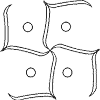source(google.com.pk)
Rangoli Biography
Rangoli is a folk art from India. Rangoli are decorative designs made on the floors of living rooms and courtyards during Hindu festivals. They are meant to be sacred welcoming areas for the Hindu deities.[1] The ancient symbols have been passed on through the ages, from each generation to the next, thus keeping both the art form and the tradition alive. The patterns are typically created with materials, including colored rice, dry flour,(colored) sand or even flower petals. Rangoli and similar practices are often followed in different Indian states; in Tamil Nadu, one has Kolam, Madanae in Rajasthan, Chowkpurna in Northern India, Alpana in Bengal, Aripana in Bihar, chowk pujan in uttar pradesh etc.Rangoli were not just a medium of decoration but it reduces negative energy and add positivity to places where it made.
The purpose of Rangoli is decoration, and it is thought to bring good luck. Design-depictions may also vary as they reflect traditions, folklore and practices that are unique to each area. It is traditionally done by women, but over the years modern additions have been adapted. Generally, this practice is showcased during occasions such as festivals, auspicious observances, celebrations of marriages and other similar milestones and gatherings.Rangoli designs can be simple geometric shapes, deity impressions, flower and petal shapes (appropriate for the given celebrations), but they can also become very elaborate designs crafted by numerous people. The base material is usually dry or wet granulated rice or dry flour, to which Sindoor (vermilion), Haldi (turmeric) and other natural colors can be added. Chemical colors are a modern variation. Other materials include colored sand and even flowers and petals, as in the case of Flower Rangolis.He painted.
Rangoli' is a Sanskrit word which means a creative expression of art through the use of color.The word rangoli may also have come from "rang" (color) + "aavalli" (row), which means row of colors, or from rang+avalli, which means creepers of colors. Basically, Rangoli is the art of drawing images and motifs on the floor and walls of one's home using different color powders. Designed with a beautiful combination of various colors, the Rangoli images create an enchanting piece of art. Basically a floor painting, a rangoli image stands for a sign of welcome. The main purpose of making rangolis in diwali is to welcome Goddess Laxmi, the Goddess of wealth, to individual homes apart from warding off the evil eye. The art of rangoli is known by different names in different regions such as "Rangoli" in Maharashtra, Alpana (in Bengal), and Kolam (in South India). Although Rangoli has its origins in Maharashtra, today it is practiced everywhere. One of the most popular arts among Indian women, rangoli is an age old custom of India, and practiced all over the country.
Rangoli is used as a symbol of religious and cultural beliefs, specifically Hindu. It is considered an important part of the spiritual process; it might be called the purification of the spirit and the prosperity that lies behind such purification. Moreover, it represents a philosophy of life that enthusiastically celebrates the impermanence of knowing and devotes itself to a constant wish to live in the present. The idea that tomorrow will be renewed, which is the purpose of the rangoli, is one of the greatest concerning this symbol. Additional house festivals or family occasions inspire the art of crafting rangoli. Women may make rangoli at the entrance to every room of the house. The hobby itself is a basic symbol of eternal innovative creation, thus symbolic of the spirit. Rangoli created with icons, such as the swastika, lotus flower, Lakshmiji step (Pegalie), etc., are considered indicators of prosperity. Many homes today craft rangoli daily. The art, then, has become a part of the modern family. This decor created for almost all except the few; it is a symbol of human spirit and thus an important means to realize cultural feelings. Rangoli symbolizes joy and happiness.
Rangoli art is an adornment or decoration that has different names in different provinces of India; for example, Uttar Pradesh in Purna, Rajasthan in Mmandn, Bihar in Aripan, Bengal Alpana in Maharashtra, Rangavallie in Karnataka, Kollam in Tamil Nadu, Andhra Pradesh in Muggu, Kumaon in Alikhthap, Kerala in Kolam, and Gujarat in Saathiyo. There are many variations on these rangolioan. In, Maharashtra, rangoli are drawn on the doors of homes so that evil forces attempting to enter are repelled. India's southern Kerala settled on the edge Onam rangoli on the occasion of flowers used to decorate is. South Indian Province - Tamil Nadu, Andhra Pradesh and Karnataka, the 'column' is some margin but their basics are unchanged. These are decorated in geometric and symmetrical मूल्यतः sizes. For rice flour or slurry is used. The back of the rice flour used to be white and easy availability. Between the thumb and forefinger of dried rice flour by putting a certain cast is dropped. Rajasthan Mandana the word was taken from the corroboration means is decoration. Mmandne various festivals, major festivals and ॠ can be categorized based on seasons. Different shapes depending on the size of it also can be shared. Kumaon 's "writing beat 'or in a variety of plotting symbols Thapa, artistic designs, Bellbutoan is used. Alikhthap of society apart - separated by different groups - different icons and art media is used. South Indian rangoli usually based on geometric shapes while at the north of the auspicious sign.












Rangoli Biography
Rangoli is a folk art from India. Rangoli are decorative designs made on the floors of living rooms and courtyards during Hindu festivals. They are meant to be sacred welcoming areas for the Hindu deities.[1] The ancient symbols have been passed on through the ages, from each generation to the next, thus keeping both the art form and the tradition alive. The patterns are typically created with materials, including colored rice, dry flour,(colored) sand or even flower petals. Rangoli and similar practices are often followed in different Indian states; in Tamil Nadu, one has Kolam, Madanae in Rajasthan, Chowkpurna in Northern India, Alpana in Bengal, Aripana in Bihar, chowk pujan in uttar pradesh etc.Rangoli were not just a medium of decoration but it reduces negative energy and add positivity to places where it made.
The purpose of Rangoli is decoration, and it is thought to bring good luck. Design-depictions may also vary as they reflect traditions, folklore and practices that are unique to each area. It is traditionally done by women, but over the years modern additions have been adapted. Generally, this practice is showcased during occasions such as festivals, auspicious observances, celebrations of marriages and other similar milestones and gatherings.Rangoli designs can be simple geometric shapes, deity impressions, flower and petal shapes (appropriate for the given celebrations), but they can also become very elaborate designs crafted by numerous people. The base material is usually dry or wet granulated rice or dry flour, to which Sindoor (vermilion), Haldi (turmeric) and other natural colors can be added. Chemical colors are a modern variation. Other materials include colored sand and even flowers and petals, as in the case of Flower Rangolis.He painted.
Rangoli' is a Sanskrit word which means a creative expression of art through the use of color.The word rangoli may also have come from "rang" (color) + "aavalli" (row), which means row of colors, or from rang+avalli, which means creepers of colors. Basically, Rangoli is the art of drawing images and motifs on the floor and walls of one's home using different color powders. Designed with a beautiful combination of various colors, the Rangoli images create an enchanting piece of art. Basically a floor painting, a rangoli image stands for a sign of welcome. The main purpose of making rangolis in diwali is to welcome Goddess Laxmi, the Goddess of wealth, to individual homes apart from warding off the evil eye. The art of rangoli is known by different names in different regions such as "Rangoli" in Maharashtra, Alpana (in Bengal), and Kolam (in South India). Although Rangoli has its origins in Maharashtra, today it is practiced everywhere. One of the most popular arts among Indian women, rangoli is an age old custom of India, and practiced all over the country.
Rangoli is used as a symbol of religious and cultural beliefs, specifically Hindu. It is considered an important part of the spiritual process; it might be called the purification of the spirit and the prosperity that lies behind such purification. Moreover, it represents a philosophy of life that enthusiastically celebrates the impermanence of knowing and devotes itself to a constant wish to live in the present. The idea that tomorrow will be renewed, which is the purpose of the rangoli, is one of the greatest concerning this symbol. Additional house festivals or family occasions inspire the art of crafting rangoli. Women may make rangoli at the entrance to every room of the house. The hobby itself is a basic symbol of eternal innovative creation, thus symbolic of the spirit. Rangoli created with icons, such as the swastika, lotus flower, Lakshmiji step (Pegalie), etc., are considered indicators of prosperity. Many homes today craft rangoli daily. The art, then, has become a part of the modern family. This decor created for almost all except the few; it is a symbol of human spirit and thus an important means to realize cultural feelings. Rangoli symbolizes joy and happiness.
Rangoli art is an adornment or decoration that has different names in different provinces of India; for example, Uttar Pradesh in Purna, Rajasthan in Mmandn, Bihar in Aripan, Bengal Alpana in Maharashtra, Rangavallie in Karnataka, Kollam in Tamil Nadu, Andhra Pradesh in Muggu, Kumaon in Alikhthap, Kerala in Kolam, and Gujarat in Saathiyo. There are many variations on these rangolioan. In, Maharashtra, rangoli are drawn on the doors of homes so that evil forces attempting to enter are repelled. India's southern Kerala settled on the edge Onam rangoli on the occasion of flowers used to decorate is. South Indian Province - Tamil Nadu, Andhra Pradesh and Karnataka, the 'column' is some margin but their basics are unchanged. These are decorated in geometric and symmetrical मूल्यतः sizes. For rice flour or slurry is used. The back of the rice flour used to be white and easy availability. Between the thumb and forefinger of dried rice flour by putting a certain cast is dropped. Rajasthan Mandana the word was taken from the corroboration means is decoration. Mmandne various festivals, major festivals and ॠ can be categorized based on seasons. Different shapes depending on the size of it also can be shared. Kumaon 's "writing beat 'or in a variety of plotting symbols Thapa, artistic designs, Bellbutoan is used. Alikhthap of society apart - separated by different groups - different icons and art media is used. South Indian rangoli usually based on geometric shapes while at the north of the auspicious sign.
Rangoli

Rangoli

Rangoli

Rangoli

Rangoli

Rangoli

Rangoli

Rangoli

Rangoli

Rangoli

Rangoli

Rangoli

Rangoli
Rangoli
Time Lapse Rangoli in diwali
Vancouver Celebrates Diwali - Creating Rangoli
No comments:
Post a Comment